1995 BUICK REGAL index
[x] Cancel search: indexPage 67 of 340
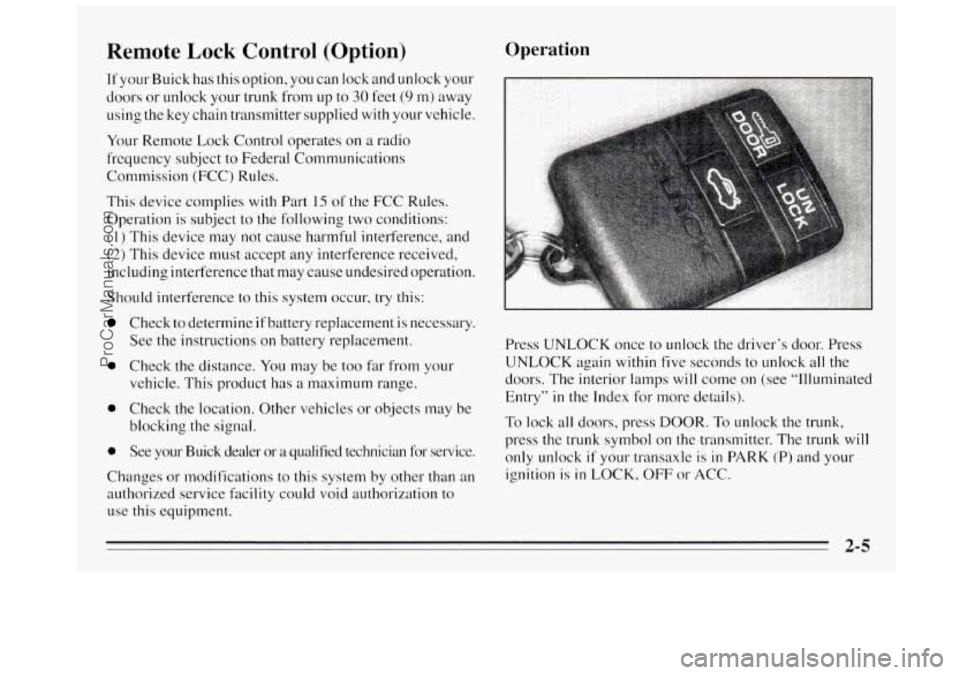
Remote Lock Control (Option)
If your Buick has this option, you can lock and unlock your
doors or unlock your trunk from
up to 30 feet (9 m) away
using the key chain transmitter supplied with your vehicle.
Your Remote Lock Control operates
on a radio
frequency subject to Federal Communications
Commission (FCC) Rules.
This device complies
with Part 15 of the FCC Rules.
Operation is subject
to the following two conditions:
(1 ) This device may not cause harmful interference, and
(2) This device must accept any interference received,
including interference that may cause undesired operation.
Should interference to this system occur,
try this:
Check to determine if battery replacement is necessary.
See the instructions on battery replacement.
0 Check the distance. You may be too far from your
vehicle. This product has a maximum range.
0 Check the location. Other vehicles or objects may be
blocking the signal.
0 See your Buick dealer or a qualified technician for service.
Changes
or modifications to this system by other than an
authorized service facility could void authorization to
use this equipment.
Operation
Press UNLOCK once to unlock the driver’s door. Press
UNLOCK again within five seconds to unlock all the
doors. The interior lamps
will come on (see “Illuminated
Entry”
in the Index for more details).
To lock all doors, press DOOR. To unlock the trunk,
press the trunk symbol on the transmitter. The
trunk will
only unlock if your transaxle is in PARK (P) and your
ignition is
in LOCK, OFF or ACC.
2-5
ProCarManuals.com
Page 71 of 340

PASS-Key@II
Your vehicle is equipped
with the PASS-Key%
(Personalized Automotive
Security System) theft
deterrent system.
PASS-Key% is a passive
theft deterrent system. This
means
you don’t have to do
anything different
to arm or
disarm the system.
It works when you insert or remove the key from
the
ignition. PASS-Key% uses a resistor pellet in the ignition
key that matches
a decoder in your vehicle.
When the PASS-Key% system senses that someone is
using the wrong key, it shuts down the vehicle’s starter and
fuel systems. For about three minutes, the starter won’t work and fuel won’t go to the engine. If someone tries to
start your vehicle again or uses another key during this
time, the vehicle will
not start. This discourages someone
from randomly trying different keys with different resistor
pellets in
an attempt to make a match.
The ignition key must be clean and dry before it’s
inserted in the ignition or the engine may not start. If the
engine does not
start and the SECURITY light is on, the
key may be dirty or wet. Turn the ignition off. Clean and dry the
key. Wait about three minutes and try
again. The security light may remain on during this
time. If the starter still won’t work, and the key appears
to be clean and dry, wait about three minutes and try
another ignition key. At this time, you may also want
to
check the fuse (see “Fuses and Circuit Breakers” in the
Index). If the starter won’t work with the other key, your
vehicle needs service. If your vehicle does start,
the first
ignition key may be faulty. See your Buick dealer or a
locksmith who can service
the PASS-Key@II.
If you accidentally use a key that has a damaged or
missing resistor pellet, the starter won’t work, and the
SECURITY light will flash. But
you don’t have to wait
three minutes before trying another ignition key.
See your Buick dealer or a locksmith who can service
the PASS-Key%
to have a new key made.
If you’re ever driving and the SECURITY light comes
on, you will be able to restart your engine if you turn it
off. Your PASS-Key% system, however, is not
working properly and must be serviced by
your Buick
dealer. Your vehicle is not protected by the
PASS-Key@II system.
If you lose or damage a PASS-Key% ignition
key,
see your Buick dealer or a locksmith who can service
PASS-Key@II
to have a new key made.
2-9
ProCarManuals.com
Page 72 of 340
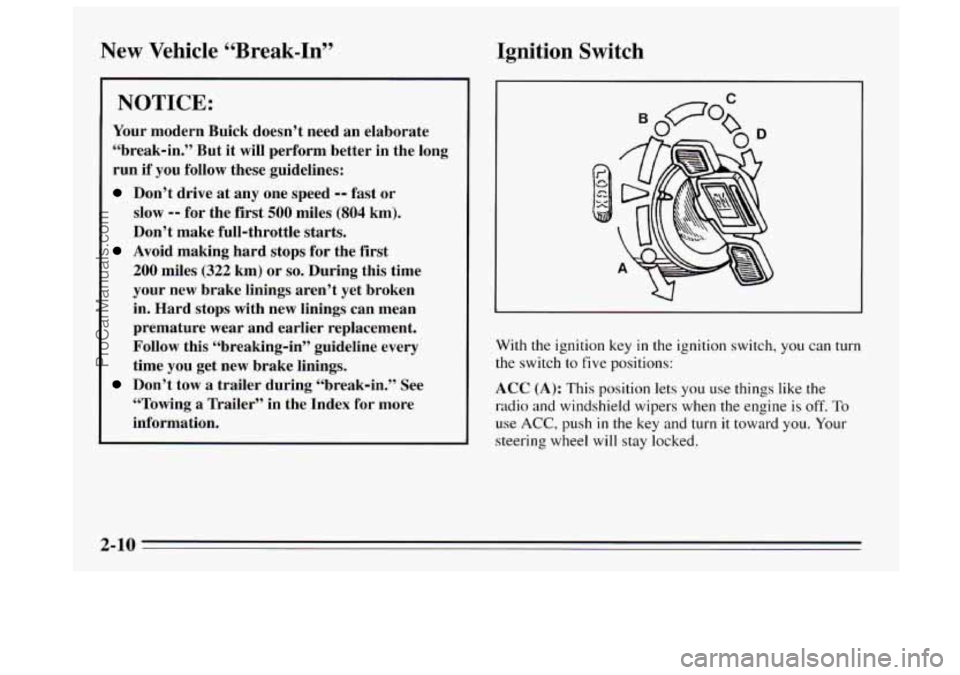
New Vehicle “Break-In”
NOTICE:
Your modern Buick doesn’t need an elaborate
“break-in.” But it will perform better in the long
run if you follow these guidelines:
Don’t drive at any one speed -- fast or
slow
-- for the first 500 miles (804 km).
Don’t make full-throttle starts.
200 miles (322 km) or so. During this time
your new brake linings aren’t yet broken
in. Hard stops with new linings can mean
premature wear and earlier replacement.
Follow this “breaking-in” guideline every
time you get new brake linings.
Don’t tow a trailer during “break-in.” See
“Towing a Trailer’’ in the Index for more
information.
Avoid making hard stops for the first
Ignition Switch
U
With the ignition key in the ignition switch, you can turn
the switch
to five positions:
ACC (A): This position lets you use things like the
radio and windshield wipers when the engine is
off. To
use ACC, push in the key and turn it toward you. Your
steering wheel will stay locked.
2-10
ProCarManuals.com
Page 73 of 340
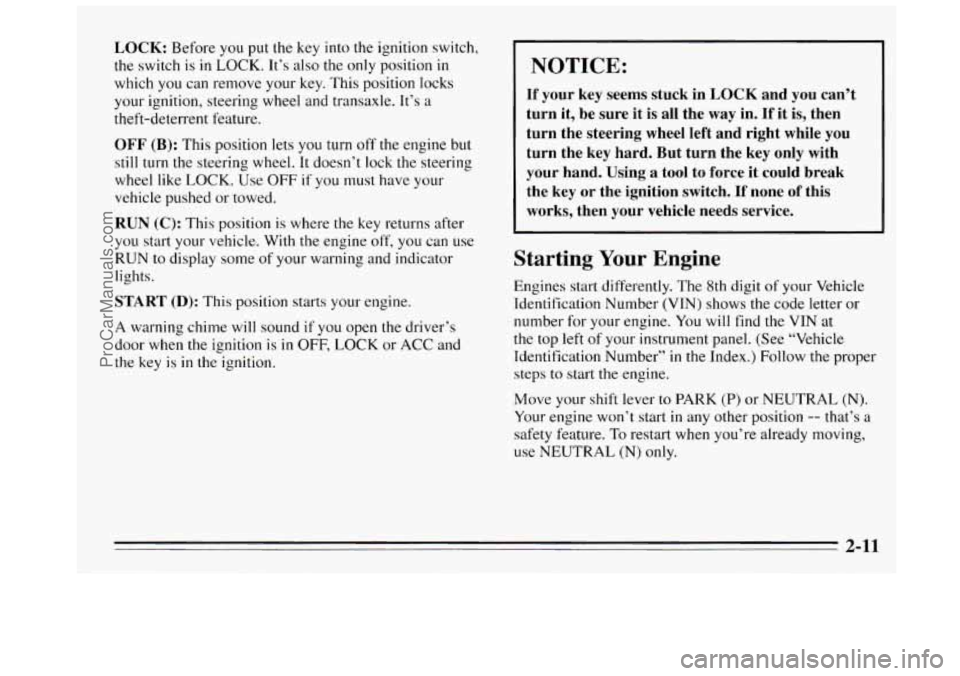
LOCK: Before you put the key into the ignition switch,
the switch is in
LOCK. It’s also the only position in
which you can remove your key. This position locks
your ignition, steering wheel and transaxle. It’s a
theft-deterrent feature.
OFF (B): This position lets you turn off the engine but
still turn the steering wheel. It doesn’t lock the steering
wheel
like LOCK. Use OFF if you must have your
vehicle pushed or towed.
RUN (C): This position is where the key returns after
you start your vehicle. With the engine off,
you can use
RUN to display some
of your warning and indicator
lights.
START (D): This position starts your engine.
A warning chime will sound if you open the driver’s
door when
the ignition is in OFF, LOCK or ACC and
the key is
in the ignition.
NOTICE:
If your key seems stuck in LOCK and you can’t
turn it, be sure it is all the
way in. If it is, then
turn the steering wheel left and right while you
turn the key hard. But turn the key only with
your hand. Using a tool to force it could break
the key or the ignition switch. If none of this
works, then your vehicle needs service.
Starting Your Engine
Engines start differently. The 8th digit of your Vehicle
Identification Number (VIN) shows the code letter
or
number for your engine. You will find the VIN at
the top
left of your instrument panel. (See “Vehicle
Identification Number” in
the Index.) Follow the proper
steps to start
the engine.
Move your shift lever
to PARK (P) or NEUTRAL (N).
Your engine won’t start
in any other position -- that’s a
safety feature. To restart when you’re already moving,
use NEUTRAL
(N) only.
2-11
ProCarManuals.com
Page 74 of 340
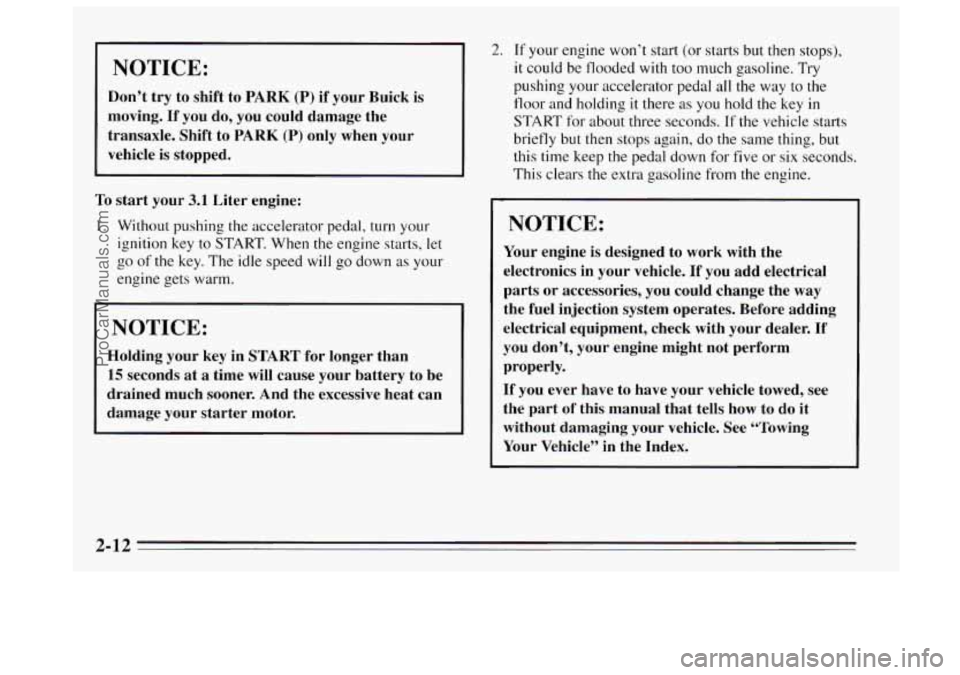
NOTICE:
Don’t try to shift to PARK (P) if your Buick is
moving.
If you do, you could damage the
transaxle. Shift to
PARK (P) only when your
vehicle is stopped.
To start your 3.1 Liter engine:
1. Without pushing the accelerator pedal, turn your
ignition key to START. When
the engine starts, let
go of the key. The idle speed will go down as your
engine gets warm.
NOTICE:
Holding your key in START for longer man
15 seconds at a time will cause your battery to be
drained much sooner. And the excessive heat can
damage your starter motor.
2. If your engine won’t start (or starts but then stops),
it could be flooded with too much gasoline. Try
pushing your accelerator pedal all the way
to the
floor and holding it there as you hold the key in
START for about three seconds. If the vehicle starts
briefly but t.hen stops again, do the same thing, but
this time keep the pedal down for
five or six seconds.
This clears the extra gasoline
from the engine.
~
NOTICE:
Your engine is designed to work with the
electronics in
your vehicle. If you add electrical
parts
or accessories, you could change the way
the fuel injection system operates. Before adding
electrical equipment, check with your dealer.
If
you don’t, your engine might not perform
properly.
If you ever have to have your vehicle towed, see
the part
of this manual that tells how to do it
without damaging your vehicle. See “Towing
Your Vehicle” in the Index.
2-12
ProCarManuals.com
Page 75 of 340
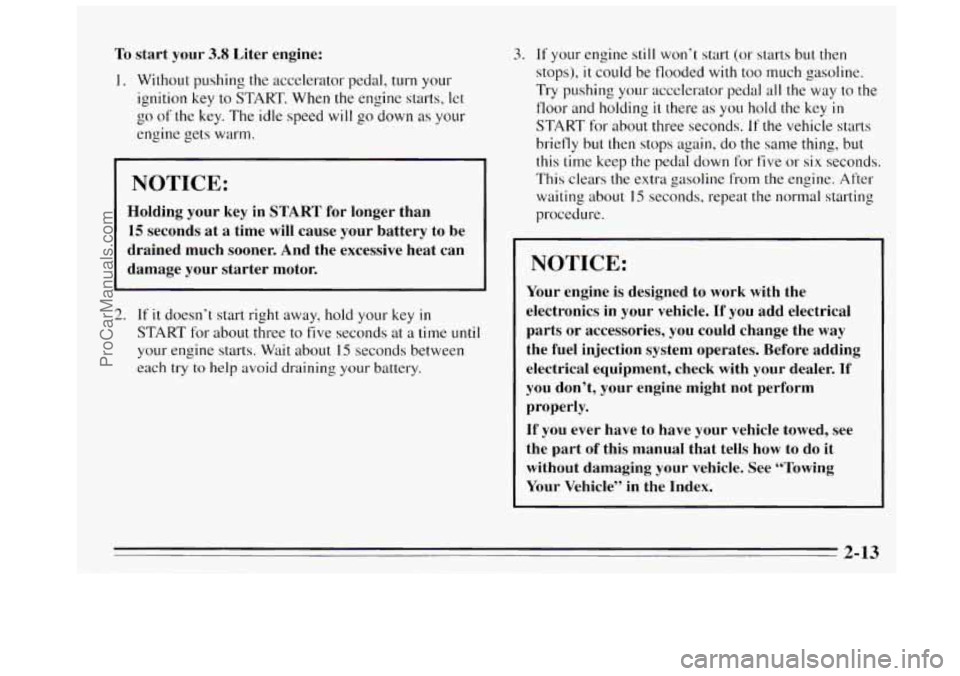
To start your 3.8 Liter engine:
I. Without pushing the accelerator pedal, turn your
ignition
key to START. When the engine starts, let
go
of the key. The idle speed will go down as your
engine gets warm.
I NOTICE:
Holding your key in START for longer than
15 seconds at a time will cause your battery to be
drained much sooner. And the excessive heat can
damage your starter motor.
2. If it doesn’t start right away, hold your key in
START for about three to five seconds at a time until
your engine starts. Wait about
15 seconds between
each try
to help avoid draining your battery.
3. If your engine still won’t start (or starts but then
stops), it could be flooded with too much gasoline.
Try pushing your accelerator pedal
all the way to the
floor and holding
it there as you hold the key in
START for about three seconds. If the vehicle starts
brietly but then stops again, do the
same thing, but
this time keep the pedal down for
five or six seconds.
This clears the extra gasoline from the engine. After
waiting about 15 seconds, repeat the normal starting
procedure.
NOTICE:
Your engine is designed to work with the
electronics in your vehicle.
If you add electrical
parts or accessories, you could change the way
the fuel injection system operates. Before adding
electrical equipment, check with
your dealer. If
you don’t, your engine might not perform
properly.
If you ever have to have your vehicle towed, see
the part of this manual that tells how to do it
without damaging your vehicle. See “Towing
Your Vehicle” in the Index.
2-13
ProCarManuals.com
Page 78 of 340
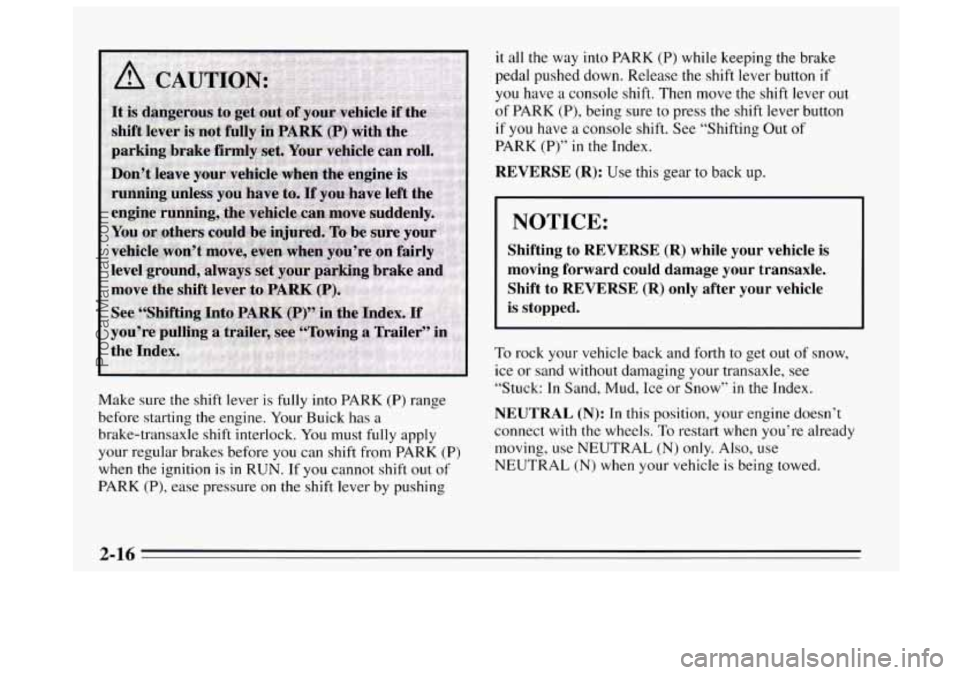
Make sure the shift lever is fully into PARK (P) range
before starting the engine. Your Buick has a
brake-transaxle shift interlock. You must fully apply
your regular brakes before you can shift from
PARK (P)
when the ignition is in RUN. If you cannot shift out of
PARK
(P), ease pressure on the shift lever by pushing
it all the way into PARK (P) while keeping the brake
pedal pushed down. Release the shift lever button
if
you have a console shift. Then move the shift lever out
of PARK (P), being sure to press the shift lever button
if you have a console shift. See “Shifting Out of
PARK (P)” in the Index.
REVERSE (R): Use this gear to back up.
NOTICE:
Shifting to REVERSE (R) while ybm vehicle is
moving forward could damage your transaxle.
Shift to REVERSE
(R) only after your vehicle
is stopped.
To rock your vehicle back and forth to get out of snow,
ice
or sand without damaging your transaxle, see
“Stuck: In Sand, Mud, Ice or Snow” in the Index.
NEUTRAL (N): In this position, your engine doesn’t
connect with the wheels.
To restart when you’re already
moving, use NEUTRAL (N)
only. Also, use
NEUTRAL (N) when your vehicle is being towed.
ProCarManuals.com
Page 81 of 340
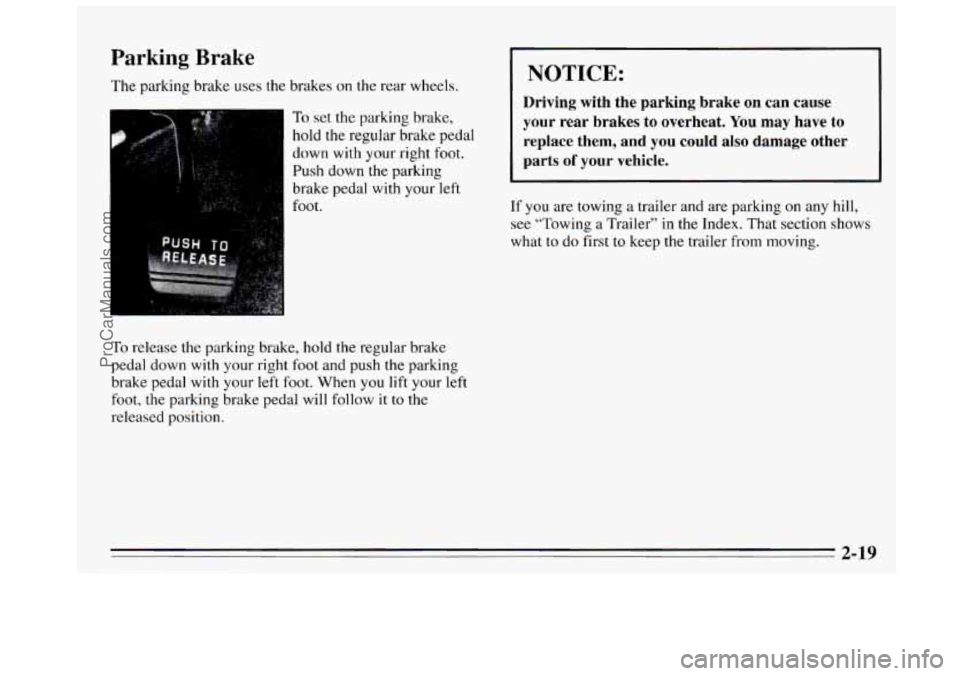
Parking Brake
The parking brake uses the brakes on the rear wheels.
To set the parking brake,
hold the regular brake pedal
down with your right foot.
Push down the parking
brake pedal with your left
To release the parking brake, hold the regular brake
pedal down with your right foot and push the parking
brake pedal with your
left foot. When you lift your left
foot, the parking brake pedal will follow
it to the
released position.
NOTICE:
Driving with the parking brake on can cause
your rear brakes
to overheat. You may have to
replace them, and
you could also damage other
parts
of your vehicle.
If you are towing a trailer and are parking on any hill,
see “Towing a Trailer” in the Index. That section shows
what to do first to keep the trailer from moving.
2-19
ProCarManuals.com